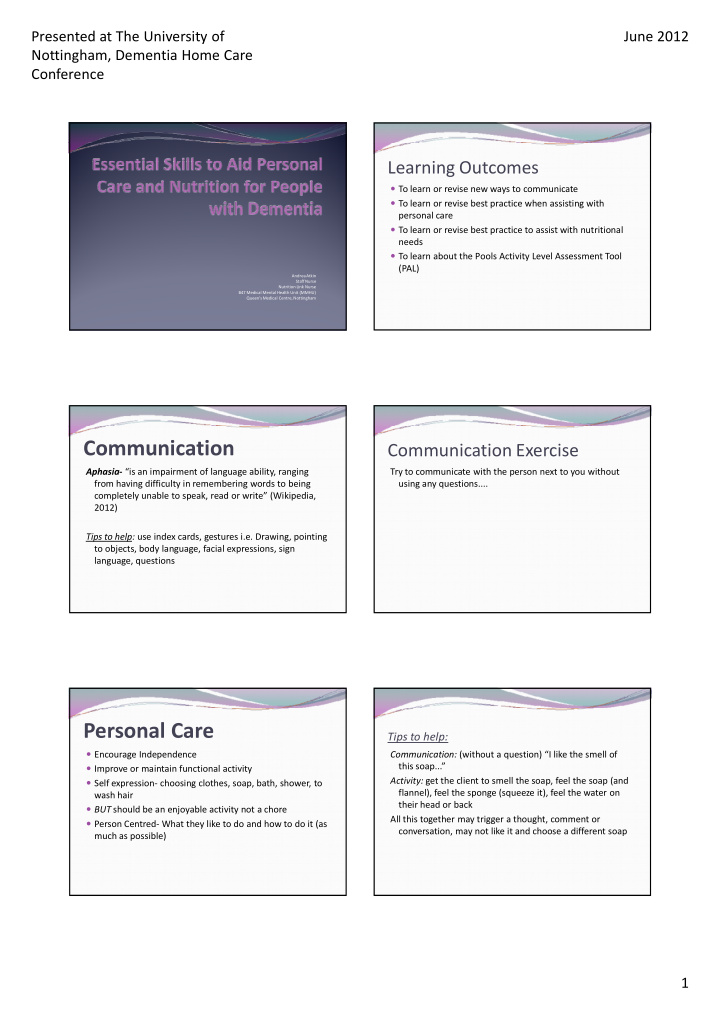



Presented at The University of June 2012 Nottingham, Dementia Home Care Conference Learning Outcomes To learn or revise new ways to communicate To learn or revise best practice when assisting with personal care To learn or revise best practice to assist with nutritional needs To learn about the Pools Activity Level Assessment Tool (PAL) AndreaAtkin StaffNurse Nutrition Link Nurse B47 Medical Mental Health Unit (MMHU) Queen’sMedical Centre, Nottingham Communication Communication Exercise Aphasia- “is an impairment of language ability, ranging Try to communicate with the person next to you without from having difficulty in remembering words to being using any questions.... completely unable to speak, read or write” (Wikipedia, 2012) Tips to help: use index cards, gestures i.e. Drawing, pointing to objects, body language, facial expressions, sign language, questions Personal Care Tips to help: Encourage Independence Communication: (without a question) “I like the smell of this soap...” Improve or maintain functional activity Activity: get the client to smell the soap, feel the soap (and Self expression- choosing clothes, soap, bath, shower, to flannel), feel the sponge (squeeze it), feel the water on wash hair their head or back BUT should be an enjoyable activity not a chore All this together may trigger a thought, comment or Person Centred- What they like to do and how to do it (as conversation, may not like it and choose a different soap much as possible) 1
Presented at The University of June 2012 Nottingham, Dementia Home Care Conference Nutrition Person Centred Care Exercise Try to think of objects, smells, sounds, tastes etc that To encourage adequate amounts of food and fluid intake remind you of a happy time or moment in your life that To monitor and assist with eating and drinking you can discuss when remembered... Should be person centred if safe to do so depending on dietary requirements Should be enjoyable, social, not a chore Other Tips: Make a meal look attractive Tips to help: Encourage different foods and fluids Communication : (without a question) “that dinner looks Encourage snacks and smells nice...” IF NOT EATING: try smaller portions Activity: get the client to look and smell the dinner, get try and give them what they fancy (if safe and able to do them to try it and tell you how it tastes, may remind them so) May need assistance if unwell (increased confusion) of a holiday etc. May only like finger foods It may be that they don’t like two hot meals a day, don’t May need adapted cutlery/ plates (OT can help) fancy it and you will need to find alternatives May need to eat or have a drink with them (sociable) May be aspirating and so wont eat (as they don’t like the idea of chocking) Make food and fluid charts for a week and check Nutrition Exercise weight once a week for 2 weeks to monitor changes Using food and fluid charts provided, try to fill them out. Get doctor to review weight loss- may need dietician Use the first on to write on what you had yesterday, and referral the second one ask the person sitting next to you. (To Monitor if coughing, wet/ hoarse voice when eating practice filling them out). as may be aspirating- will need a doctor to review, may need admission to hospital or SALT referral for a Did anything you ate or smelt trigger a memory? modified diet (as infections can occur from aspiration) Encourage communication between care staff (communication diary- care plans, charts) 2
Presented at The University of June 2012 Nottingham, Dementia Home Care Conference Pool’s Activity Level (PAL) Assessment Tool The reasons for getting the right level is so the client can feel a sense on achievement on completing the task Activities are all things that someone does in a day. These without help that wasn’t needed. This improves self include, washing, dressing, eating and drinking, watching esteem and quality of life, whist being person centred. TV, listening to the radio, having a conversation, mobilising, playing a game. (Wenborn, Challis, Pool et al, 2008) The best tool to assess at what level each activity can be achieved at is to use The Pools Activity Level Assessment Tool, developed by Jackie Pool (Pool, 2012). Pool’s Activity Level Exercise Conclusion Using the Pool’s Activity Level Assessment, think of a client Using effective communication can aid a person with and try to fill it in, you can confirm and discuss with your dementia in all activities of daily living and the carers partner. looking after them. Do you know anything about your client that may trigger Providing person centred care at a level appropriate for the memories? client using the tools provided will aid personal care and nutrition and will benefit both care workers and clients References Pool; J (2012) The Pool Activity Level (PAL) Instrument for OccupationalProfiling: A PracticalResource for Carers of People with CognitiveImpairment, 4 th Edition , London, Jessica Kingsley Publishers Wenborn; J , Challis; D, Pool; J, Burgess; J, Elliott; N and Orrell; M (2008) Assessing the validity and reliability of the Pool Activity Level (PAL) Checklist for use with older people with dementia, Aging & Mental Health , 12:2, 202 - 211 Wikipedia (2012) Aphasia [online] available at: en.wikipedia.org/wiki/Aphasia accessed on: 17/06/2012 3
Recommend
More recommend